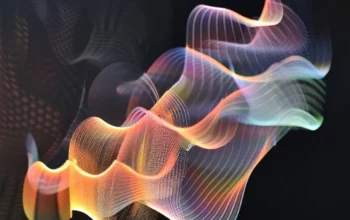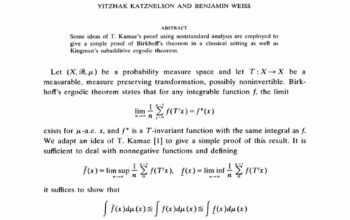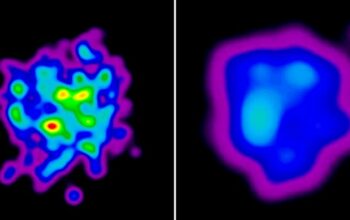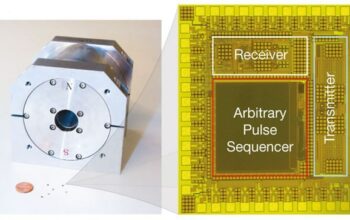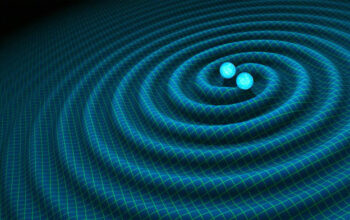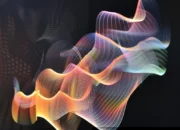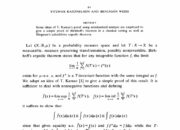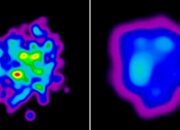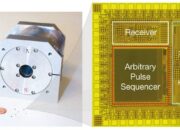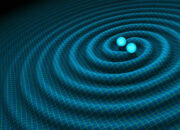The enigmatic nature of proton spin is a topic that has engendered considerable intrigue within the realm of particle physics. The conventional understanding of protons as fundamental constituents of atomic nuclei has been augmented by the realization that their intrinsic angular momentum, or spin, is not merely a trivial property; rather, it reflects complex interactions among the particles within the proton itself. This article delves deep into the intriguing interplay between quarks and gluons and elucidates how these elementary particles contribute to the overall spin of the proton.
At the heart of any discourse on protons lies a discussion on their composition. Protons, as baryons, are primarily composed of three valence quarks: two up quarks and one down quark. The spins of these individual quarks contribute to the total spin of the proton. However, the situation is far from straightforward. Quarks are not isolated entities; they are perpetually engaged in a chaotic dance, facilitated by the exchange of gluons—force-carrying particles of quantum chromodynamics (QCD). This framework, operating at the subatomic level, introduces layers of complexity that are pivotal to understanding the origins of proton spin.
An initial examination might suggest that the spins of the quarks, when combined, could effortlessly account for the proton’s total spin of ½ (in units of the reduced Planck constant). Yet, empirical evidence reveals a dissonance when we attempt to correlate the observed proton spin with the individual contributions of the quarks. Approximately only a third of the proton’s spin can be attributed to the sum of the spins of its constituent quarks, leading scientists to contemplate the contributions of other components within the proton.
The inadequacy of quark spin alone to elucidate the full picture beckons the importance of gluons. Gluons are uniquely characterized by their ability to mediate the strong force among quarks, effectively ‘gluing’ them together within the proton. These massless gauge bosons not only facilitate the binding of quarks but also possess intrinsic spin themselves, which complicates the narrative further. As gluons engage in a profusion of interactions with quarks, they contribute to the overall angular momentum of the proton through two mechanisms: spin and orbital angular momentum.
Quantifying the contribution of gluons to the proton’s spin requires a sophisticated understanding of QCD dynamics. The concept of ‘spin orbit coupling’ becomes salient here. As gluons move and interact within the proton, they can impart their angular momentum to the quarks, generating orbital angular momentum even as quarks exhibit their intrinsic spins. This intermingling leads to a situation wherein the total angular momentum of the proton is a convoluted amalgamation of the independent contributions from both quarks and gluons. The gluons, through their interactions, give rise to a ‘sea’ of virtual quark-antiquark pairs, which further complicates the calculative endeavors of physicists trying to gauge their impact on spin.
Considerable advances have been made in experimental physics in pursuit of a deeper understanding of gluon contributions to proton spin. High-energy collisions, such as those performed at the Large Hadron Collider (LHC) and other facilities, provide insights into the behavior of gluons under extreme conditions. These experiments focus on the scattering of protons, allowing physicists to collect data on the distribution of momentum among the quarks and gluons inside the proton. The results have revealed that a significant portion of the proton’s spin emerges not merely from the quarks, but is predominantly a consequence of the dynamic interactions and configurations involving gluons.
The advent of lattice QCD has catalyzed progress in theoretical physics as well. By discretizing spacetime into a grid, researchers can simulate the interactions of quarks and gluons at finite temperature and density. Lattice QCD calculations help resolve questions regarding the contributions to the proton’s spin by quantifying the respective roles of quark spin, gluon spin, and orbital angular momentum within the confines of a proton. The predictive outcomes of these simulations herald promising shifts in our understanding, suggesting that as we refine these calculations, the role of gluons may be more pronounced than traditional models have posited.
Inexplicably, the question of the spin structure of the proton intertwines with broader inquiries in theoretical physics, such as the quest for a unified theory integrating gravitational interactions with the particle physics framework. As scientists untangle these complexities, they edge closer to elucidating not just the mechanism of proton spin, but the fundamental nature of matter and forces themselves. Current explorations suggest a potential paradigm shift in how intrinsic properties of composite particles are understood, prompting one to reevaluate foundational principles within particle physics.
Ultimately, the journey to comprehend the spin of the proton illuminates the inherent intricacies of the subatomic world. The contributions of gluons, domain of quantum fluctuations, and the dynamic interplay of forces extend far beyond the simplistic notions of particle physics. As methods develop and experiments advance, a renaissance in our grasp of particle dynamics offers the tantalizing prospect of novel discoveries. Gluons, the silent architects of proton spin, are poised to reshape our comprehension of the cosmos and the underlying principles that govern its fabric.
